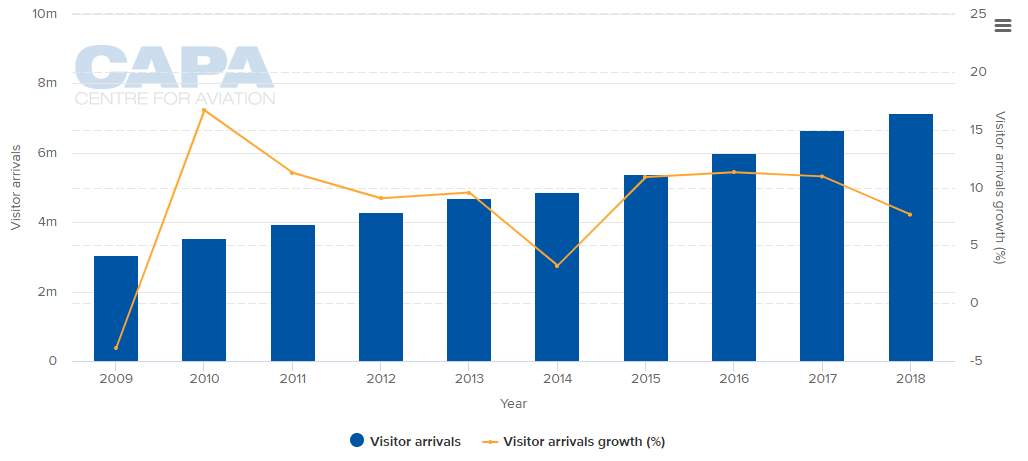Highlights:
- Visitor numbers to the Philippines increased by 8% in 2018 despite a large drop in visitor numbers to Boracay due to the island's six-month closure;
- Alternative destinations such as Palawan and Panglao filled the void, offsetting the decline in Boracay;
- Tourism in the Philippines has been growing rapidly in recent years and is posed for more rapid growth in 2019.
Visitor numbers to the Philippines increased by 8% in 2018 to 7.2 million. China was the main driver, increasing 30% to 1.3 million and accounting for 60% of the growth (about 300,000 of the 500,000 additional visitors compared with 2017).
Philippine tourism authorities fell slightly short of their initial 12% growth target for 2018. However, this was set before the decision to close Boracay. The 8% growth achieved is impressive given that Boracay was closed from late April to late October and was only partially open the last two months of the year.
CHART: The 8% growth in visitor numbers to the Philippines for 2018 represents a slight slowdown compared to the 11% growth rate achieved in 2015, 2016 and 2017 Source: CAPA - Centre for Aviation and Philippines Department of Tourism
Source: CAPA - Centre for Aviation and Philippines Department of Tourism
Boracay attracted slightly over 2 million visitors in 2017, including about half from overseas. Visitor numbers to Boracay dropped to 930,000 in 2018, including 269,000 after the reopening, according to Philippines Department of Tourism (DOT) data.
The destination reopened as scheduled on 26-Oct-2018 following an unprecedented environmental cleanup effort. However, it was not a full reopening because most of Boracay's hotels were not initially cleared to reopen, resulting in about 7,000 available hotel rooms compared to about 15,000 rooms prior to its closure.
New regulations only allow visitors to enter Boracay if they have confirmed bookings with a compliant hotel. There is also now a cap limiting the number of tourists entering the island to 6,400 per day (around 19,000 visitors at any one time based on an average stay of three days).
All the airlines serving Caticlan Airport, a short ferry ride from Boracay, have operated a significantly reduced schedule since the island reopened. Caticlan is now slated to return to pre-closure seat capacity levels in Apr-2019 (based on advanced OAG schedule data).
However, seat capacity at the other airport serving Boracay, Kalibo, is slated to still be more than 20% below pre-closure levels this summer. Kalibo, which is about two hours from Boracay, has several international flights and has traditionally offered a lower cost alternative in the domestic market. Kalibo had more total seat capacity than Caticlan prior to the closure of Boracay but this summer will have slightly less capacity.
Boracay should be close to the original 15,000 hotel room level this summer. The Philippines DOT has gradually been authorising more hotels to reopen, including nine properties (with more than 600 rooms) which were cleared earlier this month that raised the total number of available hotel rooms to nearly 12,000.
Cebu Pacific chief executive adviser Mike Szucs said shortly after Boracay reopened that while it will take time for the market to recover the "good news is it has a good long-term future. It was closed for the right reasons as frankly there was damage to the island. We think it will be a great market going forward and we are happy to be back."
As The Blue Swan Daily previously outlined, other tourist destinations in the Philippines benefited from Boracay's closure. Based on the growth in the total visitor numbers, DOT efforts to persuade visitors that were intending to holiday in Boracay last year to select other destinations in the Philippines rather than destinations in other countries was successful.
This bodes well for Philippines tourism in 2019 as alternative island destinations such as Palawan and Panglao continue to grow in popularity while Boracay gradually recovers.
See related The Blue Swan Daily reports: